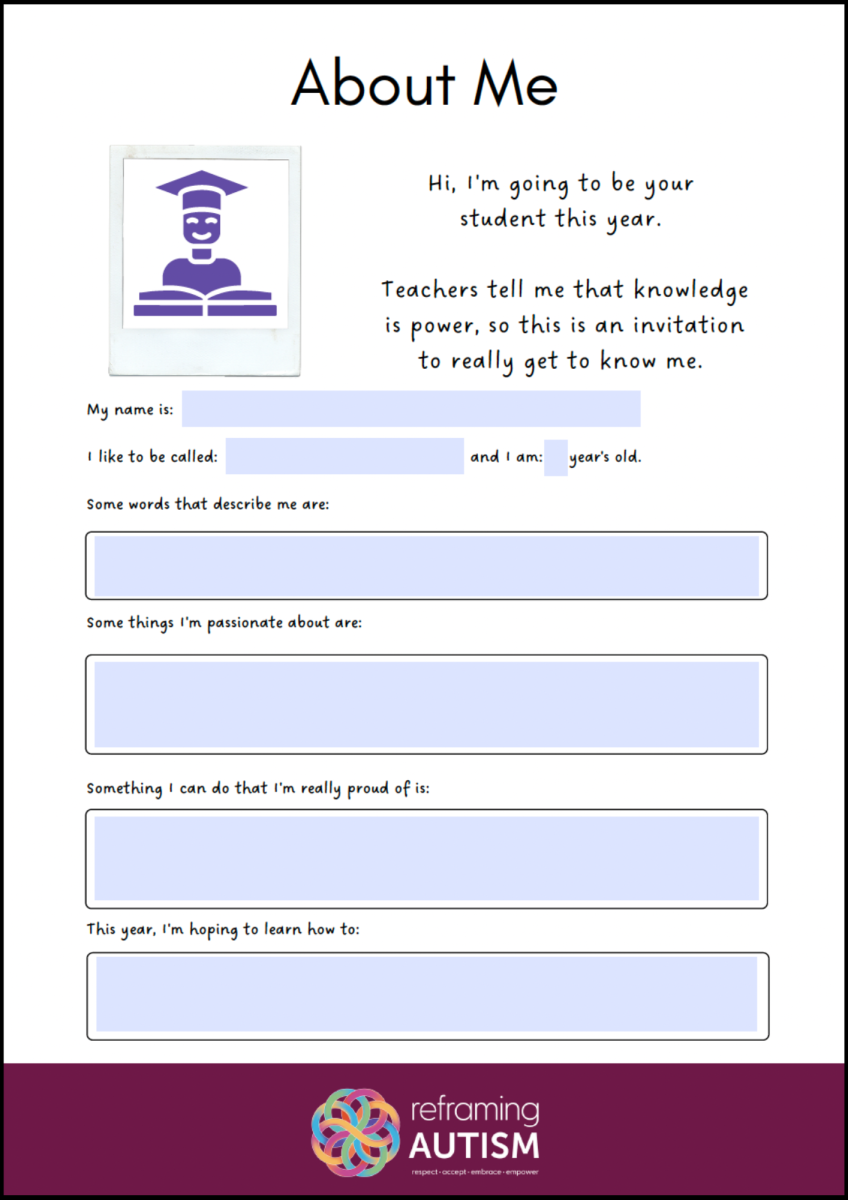
Beneath it, you will find some suggested responses from our team and our Autistic community on the classroom accommodations that would have made all the difference to our school experience. We recommend you use the table to create a bullet point list of only your child’s most important, high-level needs rather than every nuance.
In some sections, we haven’t suggested responses as these will be specific to your child.
Every Autistic child is unique, so if our downloadable template does not reflect your child’s needs, feel free to copy and paste parts into your own word document – you can borrow from ours to create your own. About Me – A Customisable Resource
Click the image of the template to open it in a new window. Toggle between the instructions on this page and your ‘About Me’ student template for ideas on what to enter in each field. Every Autistic child is an individual, so our suggestions may not apply to your child but they may spark ideas of your own.
 Page 1: About Me
Page 1: About MeThe image in the photo frame is there for you to stick a photo on top of the student icon, should you choose to print out this template rather than email it directly to your child’s teacher.
There is space to add your child’s pronouns in parentheses next to their name.
Some words that describe me are:
Below is a collection of adjectives, some of which may apply to your child.
Creative, curious, intelligent, direct, factual, energetic, knowledgeable, sensitive, kind, adventurous, honest, empathetic, helpful, imaginative, fair, cheeky, inventive, loyal, shy, tentative, compassionate, indecisive, determined, observant, trusting, meticulous, autonomous, hard-working, funny, passionate, inclusive, logical, caring, focused, perfectionistic, conscientious.
The final two responses will be unique to your child. Make sure it is what they’re proud of and what their goals are for themselves rather than what you’d like them to be.
We have tried to capture the experience of many Autistic students. However, not all of the statements on this page will necessarily reflect your child’s Autistic experience. Please strike through any parts that might not be relevant to your child.
What I find hard …
Consider any learning, sensory, communication or social differences, such as:
What can help …
What I find hard …
Consider any learning, sensory, communication or social differences, including but not limited to:
What can help …
When things are going well it will look and sound like …
Think of how your child looks and sounds when they’re engaged in one of their passions. What does their voice sound like? What does their body look like? What are the stims they use when they’re feeling competent, excited or proud of themselves?
When things are not going well it will look and sound like …
Think of how your child looks and sounds when they’re dysregulated and disengaged from an activity. What are the stims they use when they’re distressed, bored, tired, upset or frightened? Do they become mute, stutter, mumble, hum or struggle with words? What does a meltdown or a shutdown look like for them? Are they able to self-advocate or not?
I also have the following conditions …
Some frequently co-occurring conditions that could be listed here include, but are not limited to:
What can help …
Please fill this section out based on what your child’s medical practitioners suggest.
And other things I’d like you to know …
This is anything additional you’d like the teacher to consider.
What we would love to see happen this year:
This will be the hopes you have for your child and may also touch on what you hope the parent-educator partnership and communication will look like.
How we can help this year:
Here, you could mention what equipment you have at home that you can bring in for your child to use in the classroom such as wobble chairs or discs, pencil grips, ear defenders, fidgets, etc. Perhaps you have some books you’d like to donate to the school library around Autism and inclusion, or maybe you could just promise to keep the lines of communication open.

The Reframing Autism team would like to acknowledge the Traditional Owners of the lands on which we have the privilege to learn, work, and grow. Whilst we gather on many different parts of this Country, the RA team walk on the land of the Awabakal, Birpai, Whadjak, and Wiradjuri peoples.
We are committed to honouring the rich culture of the Aboriginal and Torres Strait Islander peoples of this Country, and the diversity and learning opportunities with which they provide us. We extend our gratitude and respect to all Aboriginal and Torres Strait Islander peoples, and to all Elders past and present, for their wisdom, their resilience, and for helping this Country to heal.